Topics:
Community ManagementJoin 40,000+ sales and marketing pros who receive our weekly newsletter.
Get the most relevant, actionable digital sales and marketing insights you need to make smarter decisions faster... all in under five minutes.
How to Build and Maintain an Engaged Online Community

Jul 23, 2018
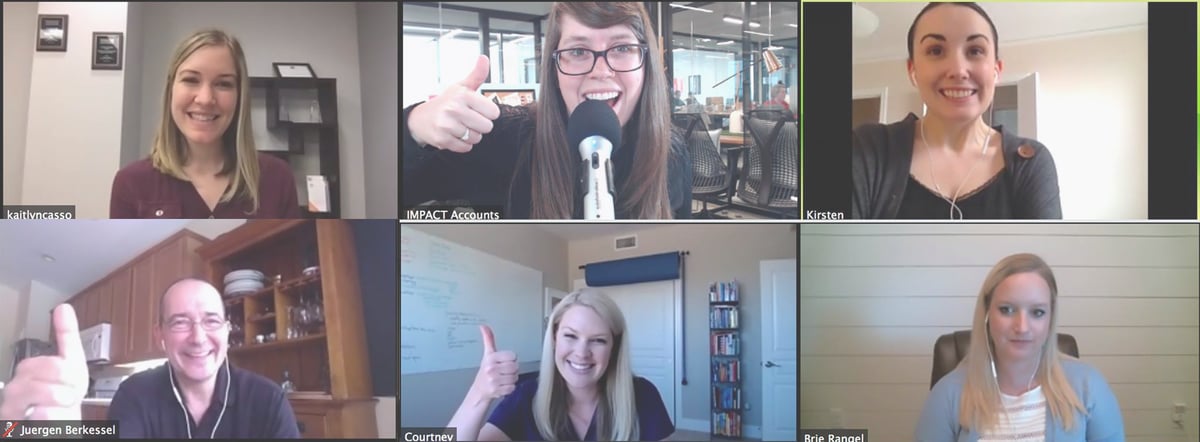
In an age of bots, automation, and machine learning, it can be easy to lose the humanity in your marketing, especially digital marketing.
An online community can be a great way to be human and helpful while still leveraging your automation for good.
Now, I know building a great community can seem overwhelming.
Should you build a community on Facebook or Slack? How will you get the right people to join and, furthermore, how will you keep them engaged?
In this article, you’ll learn how to build a vibrant online community that will continue to grow and keep people coming back for more.
Note: I’ll also be talking about this at our biggest community event of the year, IMPACT Live 2018! Don’t miss it! Get your ticket here.
There’s a Difference Between Audience & Community
When I joined the IMPACT team, we went back and forth on my job title quite a bit before settling on “Director of Audience Engagement and Community.” It was (and still is) very important to me that my job title included both “audience” and “community.”
Knowing your audience is incredibly important.
Understanding what emotional and environmental factors affect their day to day will help you connect with them and provide a lot of context for your marketing. However, an audience is simply a group of people.
An audience passively consumes your content and the dialogue is exclusively one-way. It’s not until the two-way interaction begins that your audience becomes a community.
A community is a living, breathing experience.
When your audience comments on your content, shares it, engages in discussion about it, and keeps coming back - that’s a community.
Furthermore, when you can bring members of your audience together to engage in dialogue about a topic or content together in your space, you’ve then created something truly valuable.
Why Your Business Should Build a Community
Building a community around a topic connected to your business can be a great choice. It helps with customer retention, lead generation, and even helps you with audience research.
Your Community Becomes a Resource
A vibrant community full of discussion and sharing becomes a resource for your customers. It’s a place where they can find information and get advice from your entire sphere of influence.
Plus, customers can connect, bounce ideas off one another, and build relationships that could change the course of their businesses or careers. Communities are great at giving people a sense of belonging and to remind them that they’re not alone in their challenges.
You Can Learn a Lot from Your Community
While surveys and customer research is great, you’ll never get a more realistic view of your prospects’ and customers’ challenges than when they’re interacting out in the wild.
By observing the questions they ask, the answers they give, and the way they interact with each other, you can identify trends and challenges.
It also allows you the chance to get to know more about who your customers are.
Communities Foster Retention
Being part of a great community will also help foster retention among your customers.
According to HubSpot’s recent customer acquisition study, it costs anywhere from 5 to 25 times more to acquire a new customer than to retain an existing one.
When you foster a community of your users/customers, they feel more connected and invested in your brand. They have formed a more emotional bond with your organization that is likely to help you better overcome conflicts, lead to more business, or even turn into references/referrals.
How to Choose Where Your Community Will Live
There’s a variety of options for where you can build your community.
While Slack and Facebook communities are growing in popularity, many LinkedIn groups are still being used, despite engagement in LinkedIn groups falling since 2015.
Many believe LinkedIn groups are still very useful for businesses as on LinkedIn, people are typically focused on growing professionally and are inherently in a business state of mind.
Both LinkedIn and Facebook have some limits on their groups.
On LinkedIn, you can own or manage 30 groups at a time and be a member of up to 100 groups. Meanwhile, you can join up to 6,000 Facebook groups.
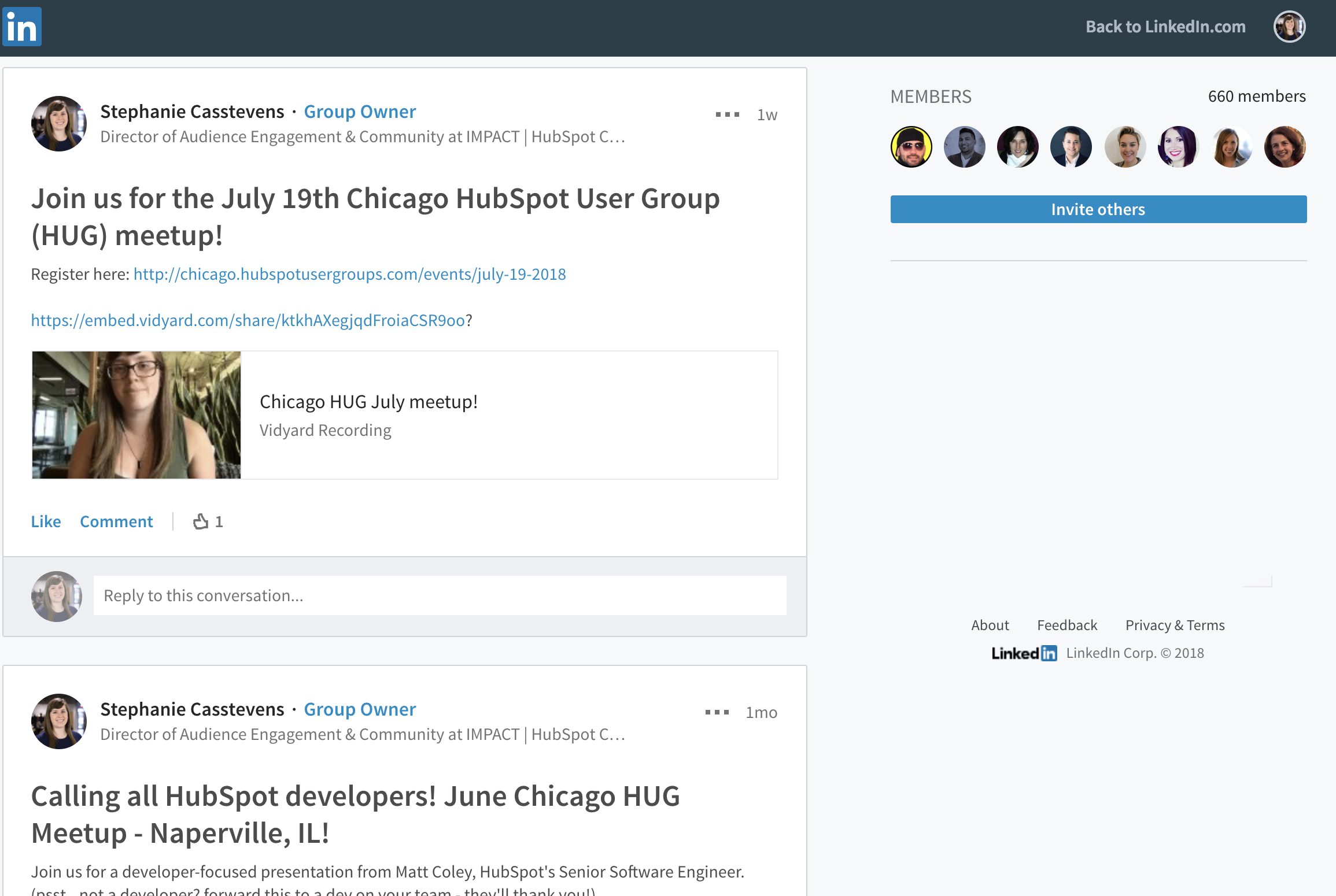
LinkedIn group membership is limited to 20,000. While there’s no official listed limit for the number of members a Facebook group can have, after 5,000 members the admins lose some management features and abilities. 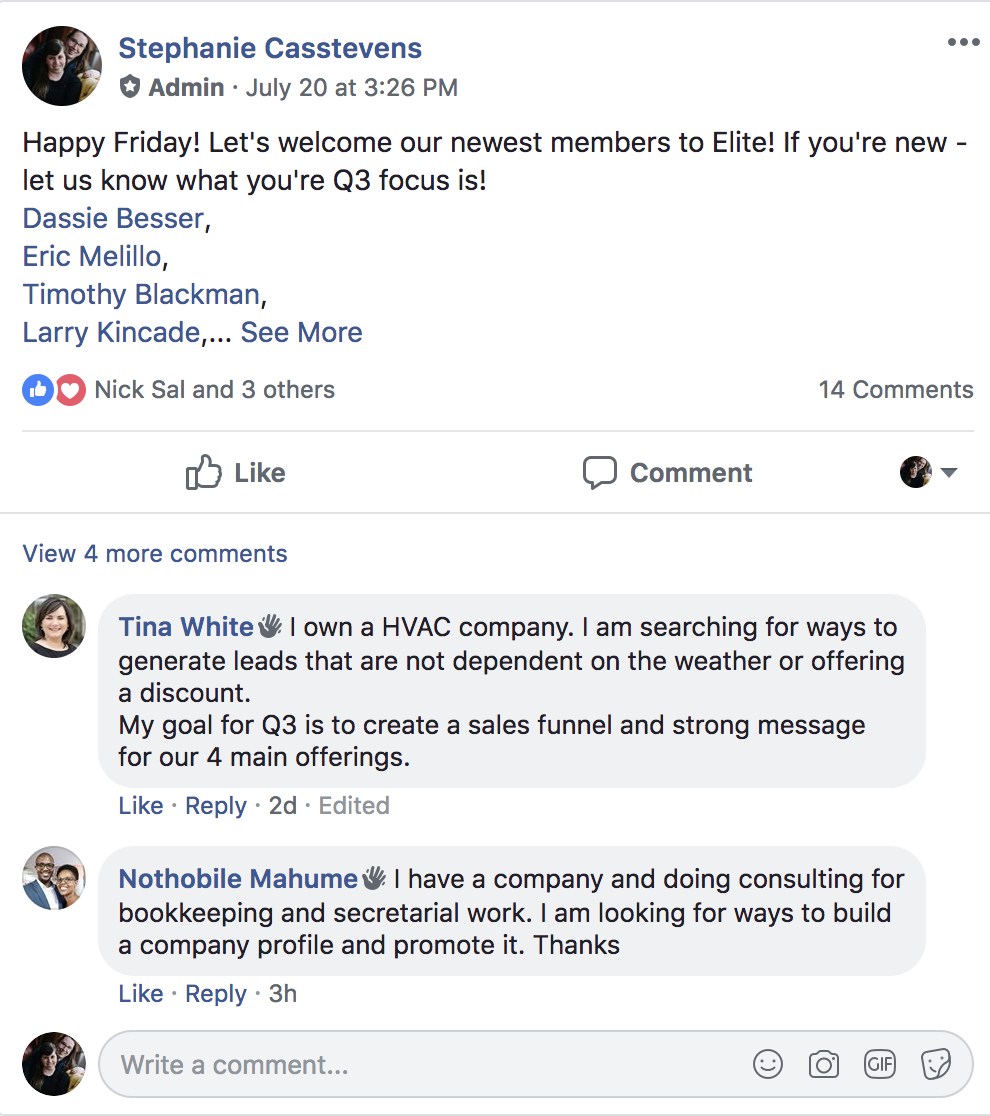
Facebook Groups have seen a bit of a renaissance in recent years, as they became one of the few ways to directly send users a notification when you post. In addition to this, Facebook continues to add new features such as the “watch party” ability.
Watch parties let you share any public video on Facebook with your group and watch it together, engaging in real time, similar to the way users engage with a live video. 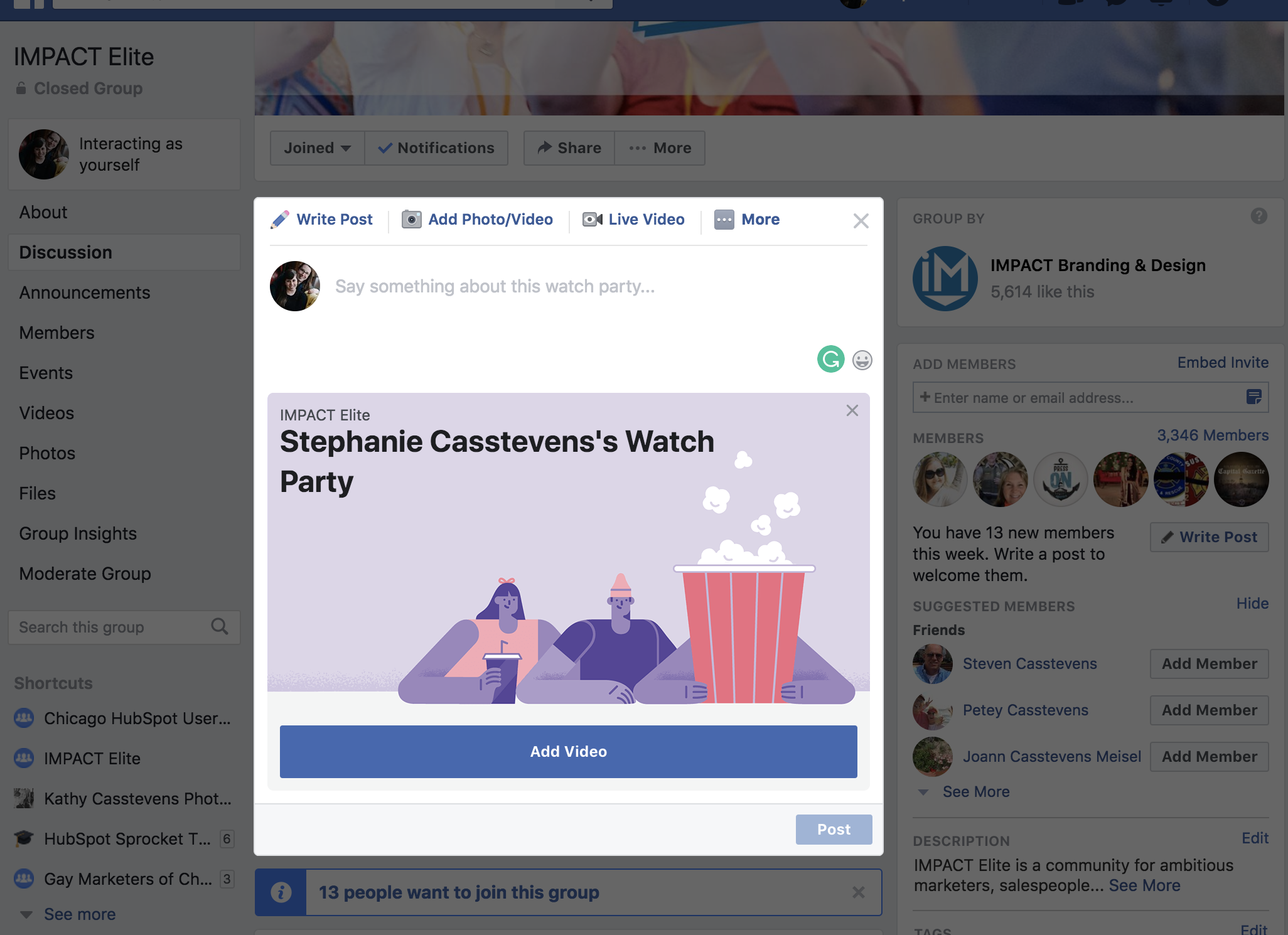
And then there’s Slack. If you don’t already know, Slack is not actually about “slacking off” at work. In fact, Slack is actually an acronym for “Searchable Log of All Communication and Knowledge.”
According to an article by Business Insider, in May of 2018 Slack had 8 million active daily users and over 500,000 organizations were using Slack.
While it is still much smaller than Facebook and LinkedIn in terms of users and existing communities, this can be a great advantage to your business.
Many people who are avid Slack users are actively looking for communities that align with their industry and interests.
In fact, IMPACT’s Carina Duffy, co-host of the Hubcast, recently worked with DigitalMarketer to launch a HubSpot user Slack. They noticed there was no Slack community just for users so they created one. 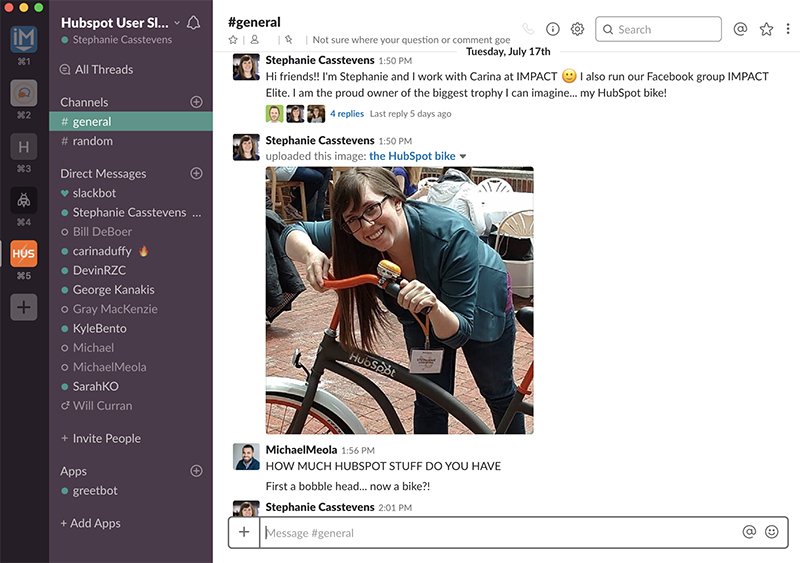
"We wanted to create a place for HubSpotters to ask questions, stay up to date, and build community together. There are channels for each Hub (marketing, sales, and service), plus additional channels for things like troubleshooting, HubSpot updates, hacks and more."
- Carina Duffy
So what will it be? Will you build a Facebook group or start a new Slack community? Whatever you end up doing, you’ll then need to start getting people to join!
Getting the Right People in The Right Place
When it comes to actually adding members to your group, there are a few things you can do to make sure you get the right people in the right place.
First, set the tone of your group. Create rules for your group and add a clear description of the purpose of your community. Pin this for all prospective and new members to read. Including an intro video where you welcome members to your group can also be a great way to set the tone right away.
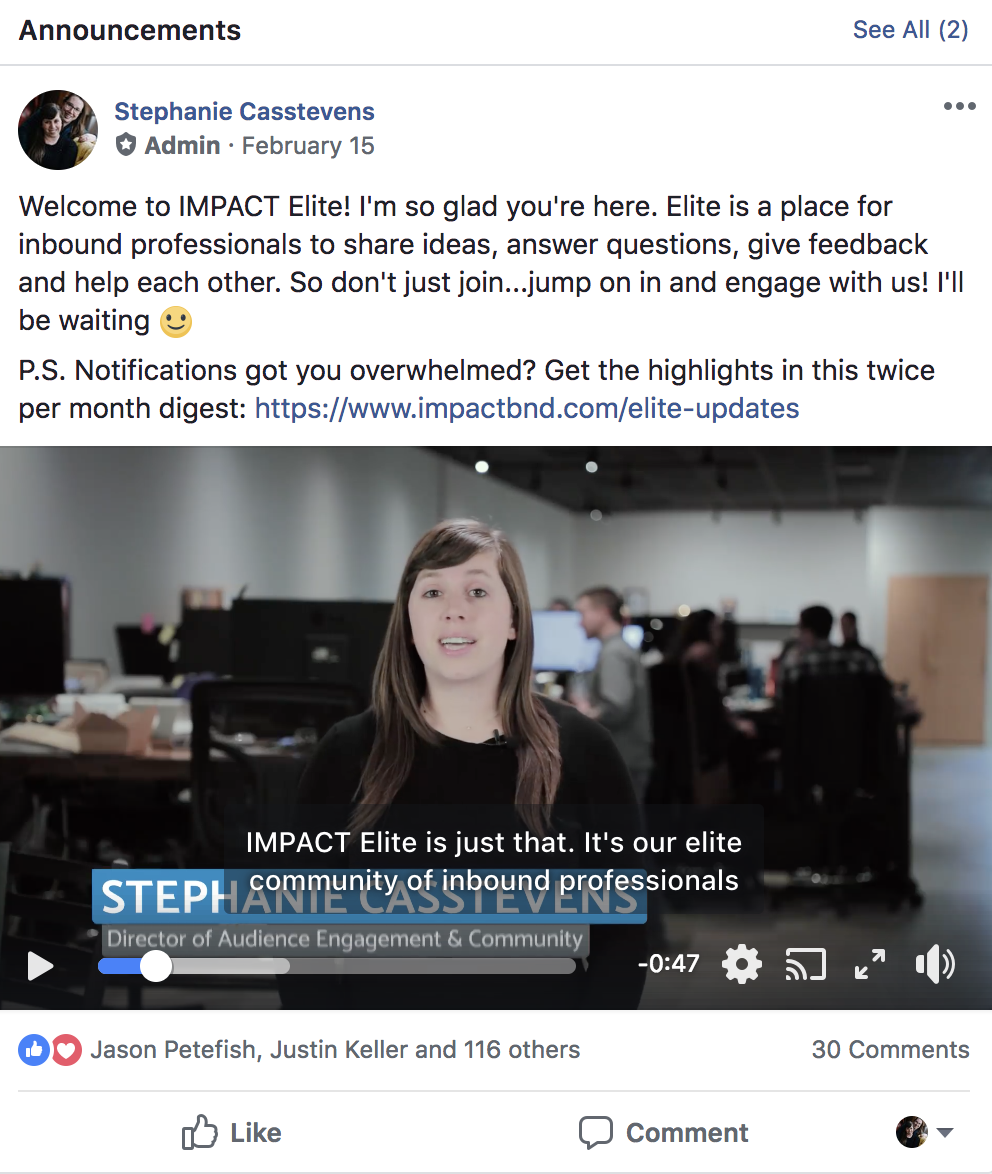
Second, ask the right questions. Facebook groups have a built-in feature that allows you to ask up to three questions of people who request to join your group.
When I took over our Facebook group, IMPACT Elite, I kept track of the answers of the first 100 members I accepted into the group. I analyzed the answers to these questions to help decide where to go to grow our group.
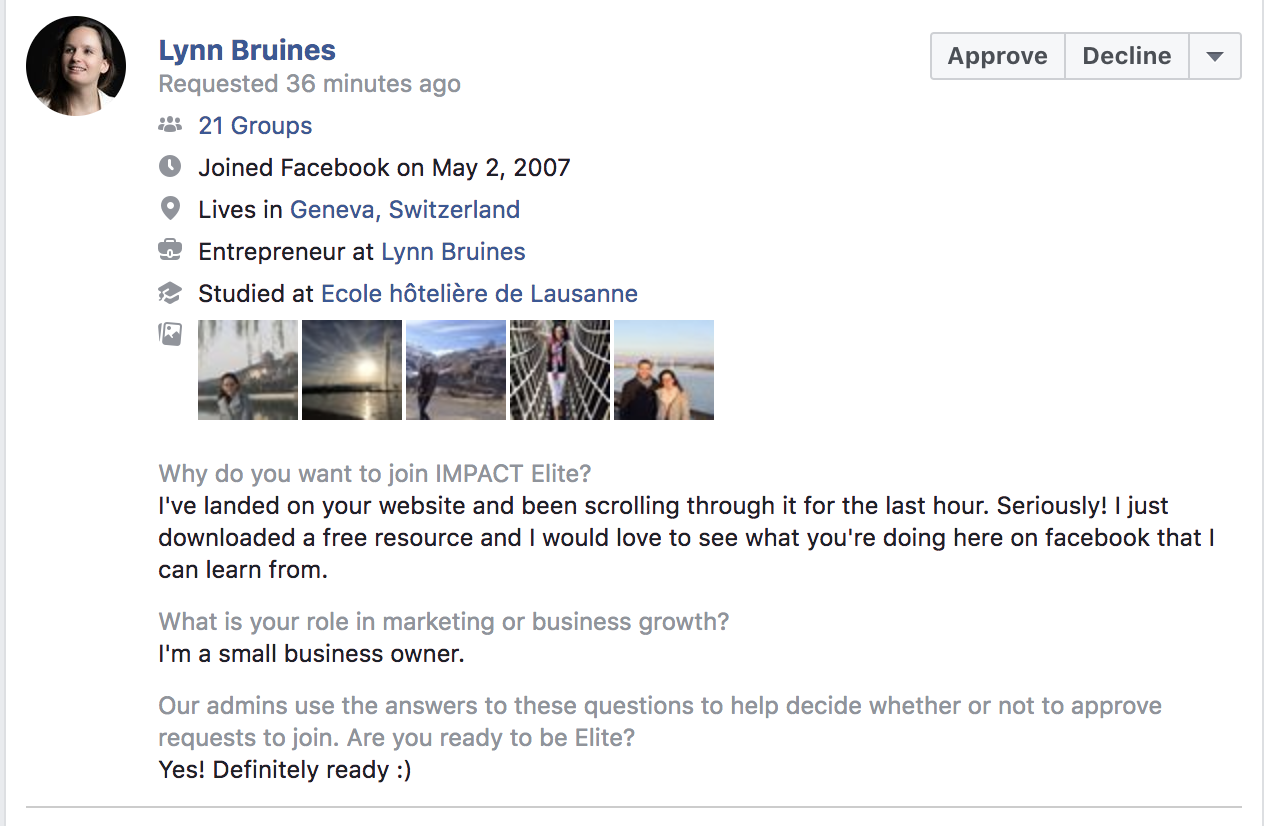
We also had a fairly high number of people ask to join IMPACT Elite but never answer the questions.
I decided to add a third question, letting people know that I would be reading their answers. Sure enough, not only did we start getting more people answering the questions, we started getting better answers as well.
You can implement this on your own as well by requiring people to submit a form on your site with a few questions before joining.
Third, encourage members to invite others who are a good fit. Then, reward them when they do so. Great communities are grown by word of mouth. Create a great experience and encourage people to tell others about it.
Driving and Maintaining Engagement within Your Community
Once you get people in your community and they start engaging, it can be easy to get comfortable. However, if you’re not actively engaging your members on a consistent basis that adds value and drives conversation, the group will grow stagnant.
Here are four ways to drive and maintain engagement in your community:
1. Use Video to Build Trust
Video, whether live or recorded, creates trust with your community by showing that you’re willing to be vulnerable by being on camera. Plus, members will benefit by being able to put a face and voice to your name.
It also reminds all members that they are having conversations with other human beings and not just computers.
Live video specifically can be a great way to interact with your community because it allows them to have a discussion with you in real time, almost face-to-face. You can make them feel special by shouting out to them during the broadcast and reading their comments out loud.
2. Consistency Yields Results
There’s no perfect answer to the question “how often should I post?” Consistency, however, does yield results. You don’t have to post every day (though you can) but if you post often and then suddenly disappear for a week, your members will notice.
Be present.
Going on vacation? Be sure to let your group know and appoint someone in your organization who can be your stand-in for the time you’re gone.
Another way to create consistency is to create segments or traditions.
From “Monday Motivation” posts to wrapping up the week on a Friday afternoon, having traditions in your group will encourage everyone to engage often and will also give you and your members something to look forward to.
3. Sharing is Caring
Just like how your community should be focused around a topic related to your brand and less on directly promoting your organization, the content you share should not be all yours either.
Sharing content that’s not written by your organization but still adds value to your group is a great way to show that you’re not just there to generate leads but that you actually want to share knowledge with your community and be helpful.
Plus, sharing content by members of the group will make them feel even more valued and encourage them to engage in conversation around their content.
4. To Respond or Not to Respond, That is the Question
Sure, some community managers respond to every single comment, but others only respond when they feel compelled to say something.
There is no magic rule here either, but, you do need to make it a priority to engage with your community.
Set aside time to respond and block it out on your calendar so that you don’t forget to check in with your group.
Remember, a post means someone took time out of their busy day to say something they thought would add value or share something they’re challenged with. This deserves to be noticed and even highlighted by you, the community manager.
From Online to In-person
Building a community will not only help you learn about your audience, it creates a resource for your customers and helps foster retention.
Whether your community lives on Slack, Facebook, LinkedIn, or somewhere else, you need to connect with your members to grow your group and maintain engagement.
Be sure to create a description of your group and clear rules for your members to set the tone from the beginning. Then, engage consistently and create traditions to encourage continued interaction within the group.
Before you know it, you’ll have a thriving community full of members answering each other's questions and connecting.
Your community may grow to be so strong, it funnels into live, in-person events, like IMPACT Live. While a lot of community building happens online, nothing beats an offline and in-person connection. I once heard someone say: “While a virtual handshake is amazing, nothing quite replaces a real-life one.”
Want to connect with our community in person and hear me talk about how we built our community? Join us at IMPACT Live!
Free Assessment:
